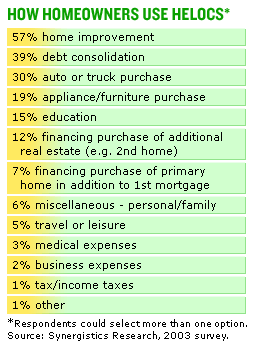
NEW YORK (CNN/Money) -
If you want to build financial security, you'll probably have a much easier time of it if you don't shoot yourself in the foot.
Sounds obvious, I know. But judging from the way some home equity lines of credit (HELOC) are touted, it sometimes seems that your banker is happy to sell you a gun and tell you all the different ways to pull the trigger.
Take, for example, one online promo for a HELOC credit card from Wells Fargo. According to the promo, its NowLine Visa Platinum Card is "a convenient way to access your home's equity without refinancing your mortgage every time you need money."
By "convenient," think 7-Eleven-Slurpee convenient: "Your credit is available 24 hours a day for everyday purchases like gas, groceries, and clothes, or whenever you need cash. NowLine can be used at millions of locations worldwide, anywhere Visa is accepted."

Judy Corcoran, a spokeswoman for Wells Fargo Financial, noted that the suggested use of a HELOC for everday purchases is just one of several possible uses the promo mentions -- the others are consolidating bills, making home improvements and buying a car, boat or recreational vehicle. "We feel it's the customer's choice," Corcoran said. "(The card) gives them another financial management tool."
Now, if a family is truly hard up for cash and faced with the awful choice of paying for life's daily expenses by credit card or using a HELOC, one could argue a HELOC is the better option because it's the least expensive in the short term.
That's because HELOCs, which are tied to the prime rate, carry lower rates than credit cards and the interest is typically tax-deductible.
But for a bank to suggest in its promos that HELOCs are a fine way to pay for dinner? I think it's indecent.
It's indecent because it encourages spending that benefits the bank and harms the homeowner.
Slippery slope
Home equity is a big key to building one's wealth. And HELOCs are secured debt -- meaning you risk losing your home if you can't pay what you owe. So if equity is going to be tapped, it should be tapped judiciously.
Groceries, gas and clothes are not judicious reasons to spend equity. (What if the homeowner pays his bill in full every month and therefore won't be charged interest? Well, then why does he need a HELOC card? A credit card is just as convenient.)
Even though there are an increasing number of U.S. homeowners with HELOCs, many don't use them, according to Tower. So lenders are looking for ways to encourage greater use of HELOCs.
So far, it appears most HELOC holders have not been squandering their equity on new jeans and coffee. Corcoran of Wells Fargo notes that the average purchase using NowLine cards is almost $400 and that there haven't been any foreclosures among NowLine card users.
And according to one survey, by Synergistics Research, 57 percent of HELOC users have spent equity on home improvement -- which is one of the best uses for a HELOC since it can actually add value to a home.
But HELOC users may be on a slippery slope.
Synergistics also found that nearly 40 percent consolidated their high-interest debt. That can be a good strategy if the debt you're consolidating is a one-time burden and not the result of persistent spending. But it's only a useful strategy if you're able to make your HELOC payments, even when rates rise. (Remember, HELOCs usually have a variable rate.)
Thirty percent, meanwhile, used equity to buy a car or truck; 19 percent purchased appliances or furniture; 6 percent used it for personal or family expenses; and 5 percent used it for travel or leisure.
The trouble with HELOCs
Certified financial planner Barbra Steinmetz has nothing against HELOCs -- in fact, she often recommends clients set one up if it costs them nothing to do so and there's no requirement that they take money out unless they actually need it.
But there's a mindset, she said, "that you have this open pocketbook you can keep going back to. I hate to see (HELOCs) used as a substitute for intelligent money management."
For example, she said, if your water heater breaks, it may be justifiable to use a HELOC if you have no other cash reserves because it's an essential purchase. A Sub-Zero refrigerator is not.
HELOCs are useful when paying for big-ticket items like a renovation or to tide you over if you have a short-term liquidity problem.
But if you're regularly reaching for the HELOC instead of the credit card for other things -- because you figure the interest is lower and tax deductible and you know you'll be carrying a balance anyway -- why not reconsider the purchase altogether?
Steinmetz puts it more bluntly. "If you can't afford it, you don't need it."
Jeanne Sahadi writes about personal finance for CNN/Money. She also appears regularly on CNNfn's "Your Money," which airs weeknights at 5 p.m. ET. For comments on this column or suggestions for future ones, please e-mail her at everydaymoney@cnnmoney.com.

|

